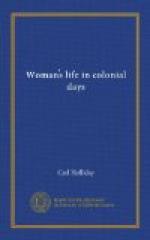XII. Society in Philadelphia
As has been indicated, New York was not the only center of brilliant social activity in colonial America. Philadelphia laid claim to having even more charming society and vastly more “exclusive” social functions, and it is undoubtedly true that for some years before the war, and even after New York became the capital, Philadelphia “set the social pace.” And, when the capital was removed to the Quaker City, there was indeed a brilliance in society that would have compared not unfavorably with the best in England during the same years. Unfortunately few magazine articles or books picturing the life in the city at that time remain; but from diaries, journals, and letters we may gain many a hint. Before and during the Revolution there were at Philadelphia numerous wealthy Tory families, who loved the lighter side of life, and when the town was occupied by the British these pro-British citizens offered a welcome both extended and expensive. As Wharton says in her Through Colonial Doorways:
“The Quaker City had, at the pleasure of her conqueror, doffed her sober drab and appeared in festal array.... The best that the city afforded was at the disposal of the enemy, who seem to have spent their days in feasting and merry-making, while Washington and his army endured all the hardships of the severe winter of 1777-8 upon the bleak hill-sides of Valley Forge. Dancing assemblies, theatrical entertainments, and various gaieties marked the advent of the British in Philadelphia, all of which formed a fitting prelude to the full-blown glories of the Meschianza, which burst upon the admiring inhabitants on that last-century May day."[224]
This, however, was not a sudden outburst of reckless joy on the part of the Philadelphians; for long before the coming of Howe the wealthier families had given social functions that delighted and astonished foreign visitors. We are sure that as early as 1738 dancing was taught by Theobald Hackett, who offered to instruct in “all sorts of fashionable English and French dances, after the newest and politest manner practiced in London, Dublin, and Paris, and to give to young ladies, gentlemen, and children, the most graceful carriage in dancing and genteel behaviour in company that can possibly be given by any dancing master, whatever.”




